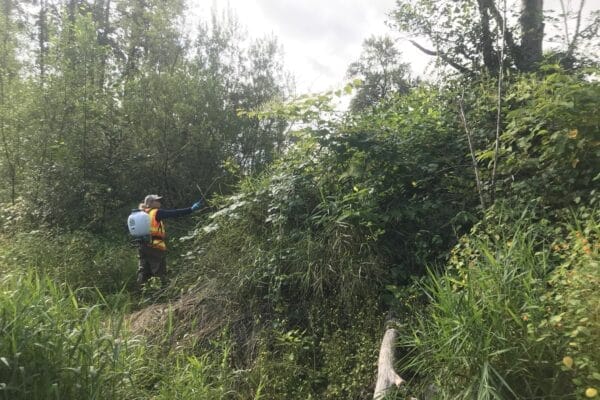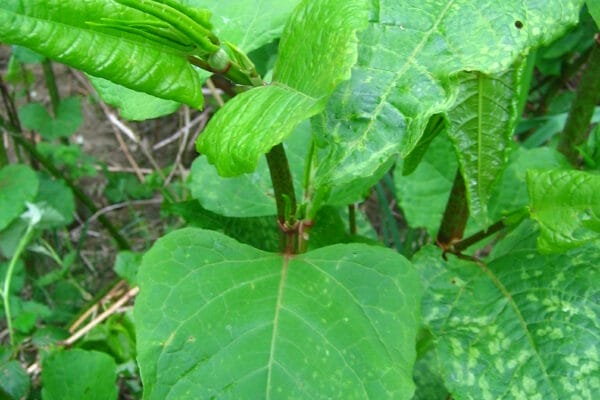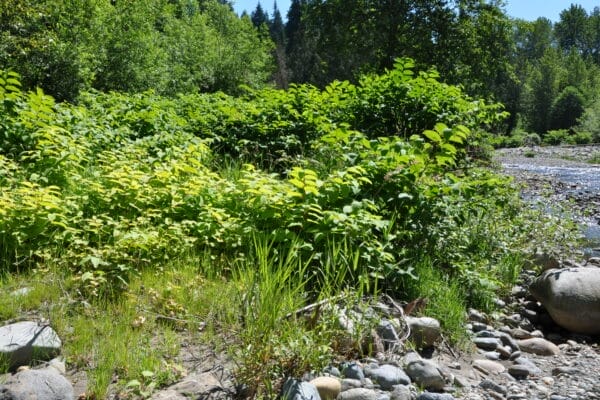What is our knotweed control program?
The Mountains to Sound Greenway Trust has been surveying and successfully treating knotweed along Issaquah Creek and the Raging River for over fifteen years. We offer not only survey and control of this highly invasive plant, but also planting of native species free of charge to private landowners. Our services are fully grant funded by King County Flood Control District Cooperative Management grant program and Washington State Department of Agriculture Knotweed Control program to support salmon recovery efforts. By removing knotweed, landowners increase the habitat value of the riverbanks on their property. This directly helps support help support local threatened salmon populations, which are food for the endangered Southern Resident Orcas.
To date we have partnered with hundreds of private landowners to control knotweed and restore stream banks by planting native trees and shrubs. Join our efforts in combatting this problem in your backyard and supporting our native salmon.

Who’s eligible?
Live on Issaquah Creek or Raging River? Then you are most likely qualified. Please fill out the form below with your address and your parcel number. You can check your parcel number here.
Timeline:
August – our team treats and surveys knotweed from within the river corridor, they do not need access to your property unless you’d like notification that they are on site. Treatment needs to occur for at least three consecutive years to be effective.
January to March – our team meets with you, if you’re interested, to look at planting opportunities on your property. We work with you to design a planting plan and install native plants, also free of charge, where knotweed once grew.
What is knotweed?

Bohemian and Itadori knotweed are non-native, highly invasive plants which spread aggressively in Western Washington. They can cause significant damage to property and Creekside habitats.
Knotweed erodes creek banks, creates flooding hazards by clogging waterways, displaces native plants, and lowers the quality of habitat for fish and native wildlife. Large infestations can negatively impact property values.
Controlling knotweed is no easy task. The roots can grow over seven feet deep and any remaining roots or stems can quickly regrow into new infestations. Digging it out is labor intensive and usually ineffective. However, without intervention, the knotweed can quickly overtake large sections of land.
What can you do?
Together, we can be the solution! For over ten years, we have worked with public grant funders and private land owners to systematically fight knotweed along Issaquah Creek and the Raging River. In that time, we have refined our approach and worked with partner organizations to develop the safest, most effective methods of control.
Different herbicide applications have been tested over the last decade, experts believe the most effective and efficient way to control the plant is foliar application of the aquatic-approved herbicide Imazapyr. This chemical works by preventing protein synthesis and cell growth within the plant. It is safe for wildlife, pets, and people – it only works on the amino acids found in plants.
Knotweed control program along Issaquah Creek
The Mountains to Sound Greenway Trust has partnered with the City of Issaquah, King County, the Washington State Parks and Recreation Commission, the Washington State Department of Natural Resources, and hundreds of private landowners over the last two decades to restore riparian habitat along Issaquah Creek. Efforts included significant vegetation management along the creek through controlling aggressive invasive weeds including Japanese knotweed, blackberry, policemen’s helmet, and butterfly bush, and installing thousands of native trees and shrubs.
In 2008 the Greenway Trust partnered with King County to survey knotweed and policemen’s helmet over the entire main stem of Issaquah Creek and its tributaries. The survey demonstrated the need for control of these weeds, particularly on private lands, and highlighted a significant opportunity to work with private landowners to reforest the Issaquah Creek basin while also educating landowners on the importance of restoring riparian habitat for spawning and juvenile salmonids. More than 65 acres of knotweed and other weeds have been treated on public and private lands, including working with 130 private landowners.
These private landowner partnerships complement the work local agencies are leading to restore habitat along Issaquah Creek. As a non-profit, the Greenway Trust has a unique ability to engage private landowners that is not available to agency partners. Over the past ten years, the Greenway Trust has created a level of trust and awareness with landowners that continues to build through targeted outreach and word of mouth. Each cycle new landowners are added, and past landowner properties are routinely revisited. This riparian restoration on private parcels significantly benefits the work on public lands by reducing the spread of knotweed downstream and reforesting riparian areas along the Issaquah Creek which builds towards achieving riparian habitat recovery goals outlined in the WRIA 8 Chinook Salmon Recovery Plan.
Knotweed Control program along the Raging River
The Raging River Knotweed Control project continues a multi-year effort to systematically control invasive knotweed along the Raging River and re-establish native vegetation through the floodplain and riparian corridor. In 2007, the Mountains to Sound Greenway Trust began working to restore the mainstem and tributaries of the Raging River, working with multiple private landowners and agency partners, including King County and the Washington State Department of Natural Resources. Over the past 10+ years, this effort has included controlling knotweed and blackberry on more than 70 gross acres, and installing more than 10,000 native trees and shrubs, including more than 1,000 conifers, in the basin.
The Raging River is one of the most important Chinook spawning locations in the Snoqualmie Watershed, and is important for steelhead trout as well. Providing an important source of gravel (which is essential for Chinook salmon spawning substrate) into the Snoqualmie River, the confluence of the two rivers is annually one of the most popular spots for Chinook to build their redds. Minimizing the negative impacts of knotweed along the Raging River is a crucial step in protecting these critical spawning areas as well as protecting the overall health of the watershed by increasing riparian forest cover and improving water quality.

After identifying knotweed as a major weed of concern for the basin, the Greenway Trust began working on restoring riparian health, starting with surveys along the Raging River in 2008. Initial phases of this effort have focused on a top-down approach to survey and control, starting at the upper reaches and moving downstream. This project is focused on continuation of efforts throughout the river corridor, continuing treatment on private lands with current relationships, adding new landowners to make further progress toward riparian restoration efforts, with work on private lands complementing public efforts to restore Chinook Salmon habitat in the Snoqualmie Watershed.
Project Funding
The Greenway Trust has now completed more than ten years of knotweed control on Issaquah Creek and the Raging River. Current funding for this work comes from the King County Flood Control District Cooperative Watershed Management grant program within the Snoqualmie Watershed Forum (Raging River) and the WRIA 8 Lake Washington/Cedar/Sammamish watershed (Issaquah Creek) and from the Past project funding has also been provided by the Washington State Department of Ecology, the City of Issaquah, and the National Fish and Wildlife Foundation.
Download our informational flyer for more information

